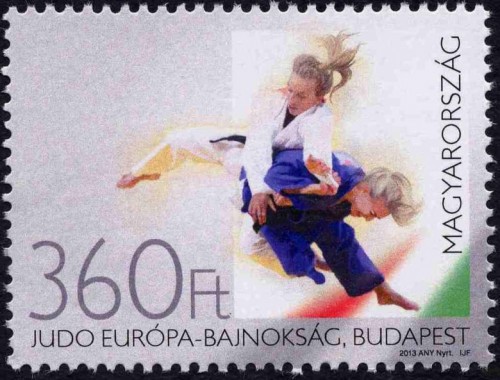
1. MAGYAR - JUDO EURÓPA-BAJNOKSÁG - Bélyeg vásárlás >>
2. ENGLISH - EUROPEAN JUDO CHAMPIONSHIPS - Order stamp >>
3. GERMAN - JUDO-EUROPAMEISTERSCHAFT - Die Bestellnummer Der Marke >>
1. MAGYAR - JUDO EURÓPA-BAJNOKSÁG
A Magyar Posta alkalmi bélyeg kibocsátásával köszönti a 2013. április 25-28. között Budapesten megrendezésre kerülő Judo Európa-bajnokságot. A női judósokat ábrázoló 360 forint névértékű bélyeg Záhonyi Tamás és Iulian Pena (az International Judo Federation (IJF) alkotói) tervei szerint százezer példányban készült az ANY Biztonsági Nyomdában.
Ötvenharmadik alkalommal rendezik meg a Judo Európa-bajnokságot. A Papp László Budapest Sportarénában ezúttal negyvenhárom ország közel ötszáz női és férfi versenyzője összesen tizennégy kategóriában méri össze tudását. A programot a Magyar Judo Múzeum a sportág hazai történetét és legszebb eredményeit bemutató tárlata teszi még színesebbé. Magyarország a zárónapon, 2013. április 28-án adja át a stafétabotot Franciaországnak, a 2014. évi Judo Európa-bajnokság szervezőjének.
Jigoro Kano (1860-1938) többdanos judomester 1882-ben alkotta meg a judóként (magyarul cselgáncs) ismert küzdősportot. Felismerte, hogy a régi japán szamurájok szellemében nem lehet tovább élni a modern Japánban, de kellenek olyan sportok, amelyekkel a gyerekek veszély nélkül kipróbálhatják erejüket és nagyon kemény fegyelemre nevelhetők. Japánban a judo több száz éves múltra visszatekintő harci művészet volt. A régi szamurájok teljes harctechnikai anyagát tartalmazta, a dobásoktól a kardkezelési eljárásokig, és mindenre kiképezte a harcosokat. Amikor megalkotta rendszerét, amit „judo”-nak nevezett el, elhagyta belőle a testi épségre veszélyes technikákat, és sportolásra alkalmassá tette, így adta azt át a gyerekeknek és felnőtteknek. Az sportág jellemzője a test-test elleni harc, az ellenfél földre dobása, gáncsolása, földön való leszorítása, karjának feszítése, illetve az ellenfél fojtó fogással való ártalmatlanná tétele. A judo 1964-től olimpiai sportág. (Forrás: eurojudo2013.hu, telesport.hu)
Forrás: Posta
2. ENGLISH - EUROPEAN JUDO CHAMPIONSHIPS
Magyar Posta is issuing a commemorative stamp to mark the European Judo championships to be held in Budapest between 25 and 28 April 2013. One hundred thousand copies of the stamp depicting female judokas with a face value of HUF 360 designed by Tamás Záhonyi and Iulian Pena (artists of the International Judo Federation) were made by the ANY Security Printing Company.
The European Judo Championships are being staged for the fifty-third time. On this occasion almost five hundred men and women from forty-three countries will compete in fourteen categories at the Papp László Sports Arena in Budapest. The event is enlivened by an exhibition of the Hungarian Judo Museum showing the history of the sport in Hungary and its greatest achievements. At the closing ceremony on 28 April 2013 Hungary will hand over the baton to France, the organisers of the 2014 European Judo Championships.
Jigoro Kano (1860-1938) created the martial art known as Judo in 1882, and attained the rank of twelfth dan, awarded only to the originator of the sport. He recognised that it was not possible to live in modern Japan in the spirit of the ancient Samurai, but saw a need for sports that taught very strict discipline and allowed youngsters to try their strength without danger. In Japan the history of Judo as a martial art dates back many centuries. Originally, the martial arts encompassed the full repertoire of the military techniques of the ancient Samurai, including training in all aspects of combat from throwing to swordsmanship. When he fashioned the discipline known as Judo from the martial arts, all techniques that endangered physical well-being were omitted, creating a sport suitable for children and adults. Judo is a physical contact sport in which the opponent is thrown to the ground, tripped, held on the ground or rendered harmless by applying leverage and holding. Judo has been an Olympic sport since 1964. (Source: eurojudo2013.hu, telesport.hu)
3. GERMAN - JUDO-EUROPAMEISTERSCHAFT
Die Magyar Posta feiert die zwischen dem 25. und 28. April 2013 in Budapest stattfindende Judo-Europameisterschaft mit der Ausgabe einer Sonderbriefmarke. Die Judo-Wettkämpferinnen abbildete Briefmarke mit einem Nennwert von 360 HUF wurde nach Entwürfen von Tamás Záhonyi und Iulian Pena (Künstler von International Judo Federation (IJF)) in einer Auflagenhöhe von 100 000 Exemplaren in der ANY Biztonsági Nyomda (ANY Sicherheitsdruckerei) hergestellt.
Die Judo-Europameisterschaft wird zum 53. Mal ausgetragen. Diesmal werden nahezu 500 Judo-Wettkämpferinnen und Judo-Wettkämpfer aus 43 Ländern in insgesamt 14 Kategorien ihre Fähigkeiten in der Papp László Budapest Sportarena messen. Die Ausstellung des Ungarischen Judo-Museums, die die heimische Geschichte und die besten Ergebnisse der Sportart präsentiert, wird das Programm noch bunter gestalten. Am Abschlusstag, am 28. April 2013, wird Ungarn den Stafettenstab an Frankreich, den Veranstalter der Judo-Europameisterschaft 2014 übergeben.
Gegründet wurde der Kampfsport Judo 1882 von Jigoro Kano (1860-1938), Judo-Meister, Inhaber mehrerer Dan. Er erkannte, dass man im modernen Japan nicht im alten japanischen Samurai-Geist weiter leben konnte, es jedoch Sportarten geben muss, in denen die Kinder ihre Kräfte ohne Risiko erproben können und ihnen eine harte Disziplin beigebracht werden kann. In Japan war das Judo eine Kampfkunst, die auf eine mehrere Jahrhunderte alte Geschichte zurückblickt. Es umfasste die gesamte Kampftechnik der alten Samurai, von den Wurf- bis zu den Schwertkampftechniken, und bildete die Kämpfer für alles aus. Als er sein System schaffte, das er „Judo” nannte, ließ er die gefährlichen Techniken weg und machte sie sporttauglich, so übergab er es an die Kinder und Erwachsenen. Kennzeichnend für Judo sind Kampftechniken, die aus Würfen, Falltechniken, Bodentechniken bestehen. Seit 1964 ist Judo eine olympische Sportart. (Quelle. eurojudo2013.hu, telesport.hu)










